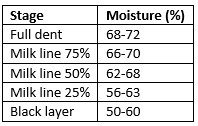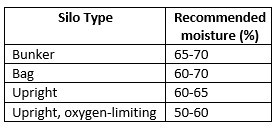GDDs August 20, 2020
Erik Smith, Area Field Crop Specialist/Team Leader
Central New York Dairy and Field Crops
Each week we will be offering the air Growing Degree Days (GDDs) for corn that have accumulated to date from 13 locations across the team 8 county area.
Four planting dates will be listed and included will be:
GDDs Season To Date
15 Year Average GDDs
30 Year "Normal" GDD
Period of Record - Max and min recorded GDDs for that time period
See: Growing Degree Day Calculator
Growing Degree Days for corn are Base 86/50 degree F and calculated by taking the average daily temperature, ((Daily Max Temp - Daily Min Temp)/2) - 50. But the maximum temperature cannot be more than 86 degree F and the minimum less than 50 degree F.
As noted previously, Joe Lawrence from the ProDairy Program suggests taking note of tasseling dates as those might serve as a better starting place to project corn silage harvest dates than planting dates. Silage harvest is likely to begin at about 800 GDDs after tasseling for 101-110 day hybrids and 750 GDDs for 96-100 day hybrids. Using the GDDs after tasseling to harvest and the Climate Smart Farming Website's 15 year GDD data it is possible to make projections as to when corn silage harvest might begin. Record Silking/Tasseling Dates for Corn Fields
Planting date GDDs continue above the 15 year average and definitely above the 30 year "normal" for the date and the May 10 and 20 planting dates are near record GDDs for this date.
If you saw tasseling/silking in the middle of July look to start harvesting corn silage the last week of August or first week of September. You should be making plans for an early start for corn silage harvest this year! It is always hard to think of corn silage being too dry, especially after 2019, but think back to 2018 where dry matters actually started to get ahead of us at harvest which also began late August to early September. Bunker silage should be ~65-70% moisture at harvest, so if you have early planted corn in some of the lower-lying areas (especially in the eastern part of the region this year!), take note of what stage you're at in the coming days:


We've noticed that fewer fields are being affected by the typical late-season foliar diseases, so the green foliage may mislead you into thinking you still have time - so check your crop to make sure you're on schedule for harvest. If you know your GDDs for your hybrid to physiological maturity(black layer) subtract off 150 GDDs to get you roughly the GDDs needed to silage harvest dry matter for that hybrid.
Some of the greatest corn yield losses can occur from drought stress at tasseling/silking. Kernels 10-14 days after silking (R2-blister stage) may abort from drought stress. While our earlier dry weather may have affected us, as of 13 August, nearly all of our growing areas in our eight counties were in the normal range (no drought): NY State Drought Monitor Map
See the attached table for more of the August 20, 2020 results. See the attached pdf for a good guide on corn development and our reference for growth stages.
GDDs August 20, 2020 (pdf; 37KB)
Visual Guide to Corn Development (pdf; 21544KB)
Upcoming Events
IPM Strategies to Protect Corn and Soybean Seed in NYS
July 22, 2025
Cobleskill, NY
Free event. DEC Credits available
Clearing Hurdles to Improve Milk Quality Conference
July 22 - July 24, 2025
Rochester, NY
three day conference with short courses, seminars, and farm tours
Announcements
Sign Up for Our Weekly E-Newsletter
We send out a bi-weekly e-newsletter that has announcements, upcoming programs, and opportunities for you! Registration is quick, easy, and free. Click here to sign up today!Document and Share Storm Damage
Mother nature has really been difficult over the last few days. Significant damage has been seen throughout NYS. Please let us know what types of damage your farm may have sustained during this time. This could be in the form of property damage, lost power, milk dump due to lost power, loss of livestock, loss of stored feed or growing crops.Farms are encouraged to DOCUMENT AND SHARE any impacts the weather may have had on their home or business. This could include structure damage, crop loss, inventory loss due to power outages, damage to equipment or fencing, and more.
If your farm experienced any sort of damage, please reach out to any of the folks listed below (or all of them). The more impact information that is collected, the greater the likelihood of a disaster declaration which can bring vital emergency support and awareness. The CNYDLFC Team will continue to collect detail and submit to NYSDAM and the EDEN network.
Reporting Weather Related Impacts (For your home or farm business)
- First, ensure that all the people and animals on your farm are safe, and that there aren't any unsafe working conditions created because of the weather (check your structures!). If there's an emergency, call 911 - don't try to manage it all on your own.
- Second, document all negative weather impacts for your farm and their estimated financial cost. Take photos, make estimates, and put it all in a safe place.
- Reach out to your insurance providers - farm, vehicle, crop, etc. to initiate the claim process as needed.
- Then, share your farm's damage with any (or all) of the ag support agencies listed below. We all work together to collect storm damage information and funnel it up to Ag and Markets which can initiate a natural disaster declaration.
- Chenango: 607-334-5841
- Fulton/Montgomery: 518-853-2135
- Herkimer: 315-866-7920
- Madison: 315-684-3001
- Otsego: 607-547-2536
- Schoharie: 518-234-4303
- Saratoga: 518-885-8995
- Erik Smith: 315-219-7786
- Daniela Gonzalez: 315-749-3486
- Ashley McFarland- 315-604-2156
Your county USDA/FSA service center.
- Chenango: 607-334-3231
- Fulton/Montgomery: 518-853-4015
- Herkimer: 315-866-2520
- Madison:315-824-9076
- Otsego: 607-547-8131
- Schoharie: 518-295-8600
- Saratoga: 518-692-9940
Your county farm bureau manager
- Region 3: Bailey Coon: 518-937-0566
- Region 5: John Wagner: 315-761-9770
- Region 6: Natally Batiston: 518-937-0269
- Region 7: Todd Heyn: 518-431-9338
Please let us know how we can help you.
Cash Rent and Custom Harvest Survey
To date, there is limited information available about rental rates and fees for crop harvesting. Farms can use this valuable information for their farm business planning to help improve decision making and profitability.Farmers Can Join MeatSuite For Free!
MeatSuite.com is a free resource provided by Cornell University where NY meat farmers can create a farm profile and list their bulk (wholes, halves, quarters) and bundled (i.e. Grilling Bundle) meat products.Why should farmers join?
1. It's free and easy!
2. Connect with more local customers. In the past year the MeatSuite.com farm directory had 8,300 visits from New York consumers. Farm profiles get as many as 25 views per month from potential local customers. We also spotlight MeatSuite farms on social media and bring attention and purchases to farms through highlights and giveaways.
How do I join?
Farmers can visit https://www.meatsuite.com/farmers/ to create a free farm profile. You must list at least one product for your farm's profile to go live. You'll also have access to Cornell's free Meat Price Calculator, a helpful tool for pricing your meat to make a profit.
While you're on MeatSuite, check out the "Creating Consumer-Friendly Bulk Meats" publication on the log-in page. It has tips on how to create bulk meat products that are easier for first-time buyers to say "yes" to.
If you have any questions as you create your farm profile or products, we're here to help! Please email Matt LeRoux at mnl28@cornell.edu.




